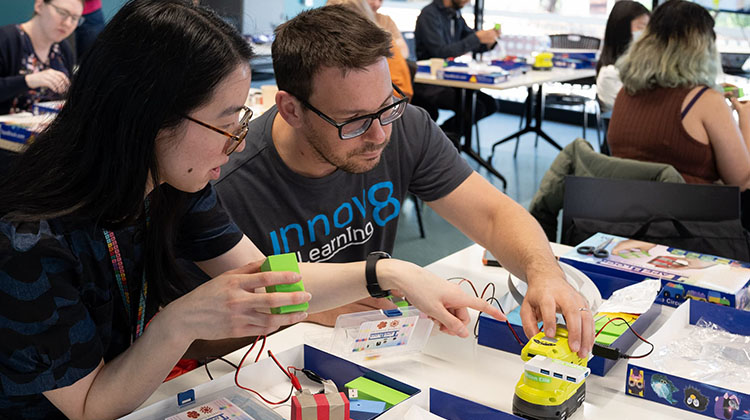Getting Started with Circuit Making

Circuits underpin all the electronics we use every day, but making circuits is quite fiddly and that makes it hard for the disabled or the very young to build them.
TapeBlocks were created directly in response to lack of inclusion of people with disabilities in STEM engagement. They were originally aimed at adults with disabilities for National Science week in 2019 and started as light and power blocks using 3V button cell batteries.
Inventor Associate Professor Kirsten Ellis who works at Monash University says, “They have evolved into a wide range of circuit making activities with components including multicolour lights, vibration motors and fans incorporated into learning blocks, characters and vehicles.
“I have been using TapeBlocks for over 5 years and I am still discovering creative ways to use and incorporate TapeBlocks,” Assoc Prof Ellis says.
TapeBlocks are being used by disability support organisations around the world as well as at schools with mainstream and supported classes. TapeBlocks have also been used in aged care facilities to diversify the range of activities for residents.
“Because TapeBlocks have a very gradual learning curve it is possible to teach others how to use them within minutes,” says Ellis.
Participants in regular 2-hour TapeBlocks workshops will feel very confident to teach TapeBlocks and integrate them into a range of creative projects after the workshop.
There are tonnes of products to build, tutorials and videos are available on the website on how to use them and start to produce creative projects.
TapeBlocks are a natural fit for Makerspaces, which provide an opportunity for learning without judgement and assessment that is too often the focus in education.
“Makerspaces actively support trying things that you have not done before that you are not good at without the pressure of performance which reduces anxiety. They provide hands-on activities, collaboration and opportunities for peer assistance which are a great antidote for the isolation that is often associated with digital technologies. Sometime learning should not be judged and should be intrinsically motivated, makerspaces are a great environment for learning the important megaskills that make great communities.
“Makerspaces provide a range of opportunities for collaboration with industry, especially for people with disabilities. Makerspaces are an environment that fosters collaboration and authentic co-design so that people with disabilities can provide input on the technologies that they use.
“In addition, making can be a pathway to Micro business for people with disabilities who can provide niche products for specific needs based on lived experience,” says Assoc Prof Ellis.
TapeBlocks is both accessible and rewarding, feedback from users gathered at a recent workshop included:
“I really like how easy the tape blocks are to use… the thickness of the tape is really good too - as the copper tape I used in the past was too thin and fiddly…”
“Thank you so much. My 5 and 7 y.o thoroughly enjoyed this PL with me! Definitely got me more confident because this is SO easy.”
“Thank you so much for your energy and great presentation. We are currently learning circuits in Year 6 and I can see how this will be something to consider next time I teach this component of STEM. Really appreciate it.”